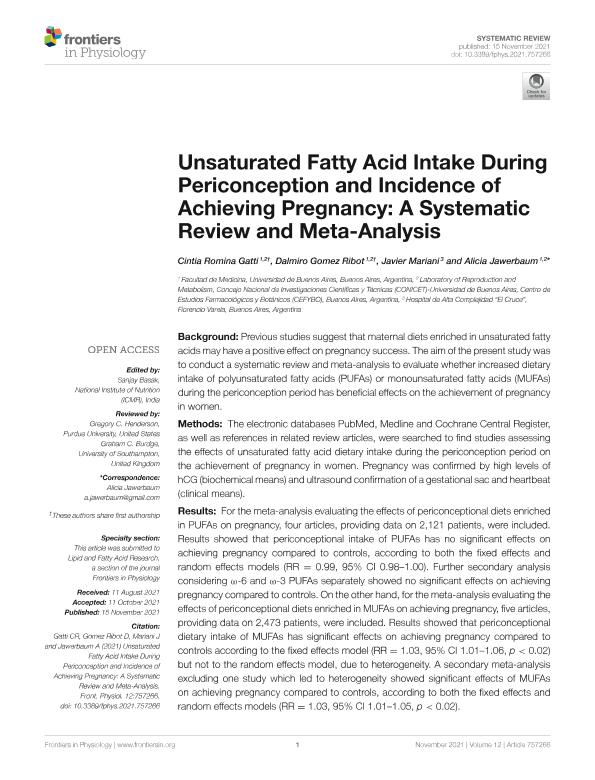Mostrar el registro sencillo del ítem
dc.contributor.author
Gatti, Cintia Romina

dc.contributor.author
Gomez Ribot, Dalmiro Leonardo Antonio

dc.contributor.author
Mariani, Nestor Javier

dc.contributor.author
Jawerbaum, Alicia Sandra

dc.date.available
2022-09-08T18:43:16Z
dc.date.issued
2021-11
dc.identifier.citation
Gatti, Cintia Romina; Gomez Ribot, Dalmiro Leonardo Antonio; Mariani, Nestor Javier; Jawerbaum, Alicia Sandra; Unsaturated fatty acid intake during periconception and incidence of achieving pregnancy: a systematic review and meta-analysis; Frontiers Media; Frontiers in Physiology; 12; 11-2021; 1-13
dc.identifier.uri
http://hdl.handle.net/11336/168045
dc.description.abstract
Background: Previous studies suggest that maternal diets enriched in unsaturated fatty acids may have a positive effect on pregnancy success. The aim of the present study was to conduct a systematic review and meta-analysis to evaluate whether increased dietary intake of polyunsaturated fatty acids (PUFAs) or monounsaturated fatty acids (MUFAs) during the periconception period has beneficial effects on the achievement of pregnancy in women. Methods: The electronic databases PubMed, Medline and Cochrane Central Register, as well as references in related review articles, were searched to find studies assessing the effects of unsaturated fatty acid dietary intake during the periconception period on the achievement of pregnancy in women. Pregnancy was confirmed by high levels of hCG (biochemical means) and ultrasound confirmation of a gestational sac and heartbeat (clinical means). Results: For the meta-analysis evaluating the effects of periconceptional diets enriched in PUFAs on pregnancy, four articles, providing data on 2,121 patients, were included. Results showed that periconceptional intake of PUFAs has no significant effects on achieving pregnancy compared to controls, according to both the fixed effects and random effects models (RR = 0.99, 95% CI 0.98–1.00). Further secondary analysis considering ω-6 and ω-3 PUFAs separately showed no significant effects on achieving pregnancy compared to controls. On the other hand, for the meta-analysis evaluating the effects of periconceptional diets enriched in MUFAs on achieving pregnancy, five articles, providing data on 2,473 patients, were included. Results showed that periconceptional dietary intake of MUFAs has significant effects on achieving pregnancy compared to controls according to the fixed effects model (RR = 1.03, 95% CI 1.01–1.06, p < 0.02) but not to the random effects model, due to heterogeneity. A secondary meta-analysis excluding one study which led to heterogeneity showed significant effects of MUFAs on achieving pregnancy compared to controls, according to both the fixed effects and random effects models (RR = 1.03, 95% CI 1.01–1.05, p < 0.02). Conclusion: The meta-analysis of published clinical studies suggests that diets enriched in MUFAs, although not those enriched in PUFAs, may have a positive effect on pregnancy success as determined by HCG and ultrasonography.
dc.format
application/pdf
dc.language.iso
eng
dc.publisher
Frontiers Media

dc.rights
info:eu-repo/semantics/openAccess
dc.rights.uri
https://creativecommons.org/licenses/by/2.5/ar/
dc.subject
MATERNAL DIET
dc.subject
MUFA
dc.subject
PERICONCEPTIONAL PERIOD
dc.subject
PREGNANCY SUCCESS
dc.subject
PUFA
dc.subject.classification
Otras Ciencias de la Salud

dc.subject.classification
Ciencias de la Salud

dc.subject.classification
CIENCIAS MÉDICAS Y DE LA SALUD

dc.title
Unsaturated fatty acid intake during periconception and incidence of achieving pregnancy: a systematic review and meta-analysis
dc.type
info:eu-repo/semantics/article
dc.type
info:ar-repo/semantics/artículo
dc.type
info:eu-repo/semantics/publishedVersion
dc.date.updated
2022-09-07T14:30:01Z
dc.identifier.eissn
1664-042X
dc.journal.volume
12
dc.journal.pagination
1-13
dc.journal.pais
Suiza

dc.journal.ciudad
Basilea
dc.description.fil
Fil: Gatti, Cintia Romina. Consejo Nacional de Investigaciones Científicas y Técnicas. Oficina de Coordinación Administrativa Houssay. Centro de Estudios Farmacológicos y Botánicos. Universidad de Buenos Aires. Facultad de Medicina. Centro de Estudios Farmacológicos y Botánicos; Argentina
dc.description.fil
Fil: Gomez Ribot, Dalmiro Leonardo Antonio. Consejo Nacional de Investigaciones Científicas y Técnicas. Oficina de Coordinación Administrativa Houssay. Centro de Estudios Farmacológicos y Botánicos. Universidad de Buenos Aires. Facultad de Medicina. Centro de Estudios Farmacológicos y Botánicos; Argentina
dc.description.fil
Fil: Mariani, Nestor Javier. Consejo Nacional de Investigaciones Científicas y Técnicas; Argentina. Provincia de Buenos Aires. Ministerio de Salud. Hospital Alta Complejidad en Red El Cruce Dr. Néstor Carlos Kirchner Samic; Argentina
dc.description.fil
Fil: Jawerbaum, Alicia Sandra. Consejo Nacional de Investigaciones Científicas y Técnicas. Oficina de Coordinación Administrativa Houssay. Centro de Estudios Farmacológicos y Botánicos. Universidad de Buenos Aires. Facultad de Medicina. Centro de Estudios Farmacológicos y Botánicos; Argentina
dc.journal.title
Frontiers in Physiology
dc.relation.alternativeid
info:eu-repo/semantics/altIdentifier/url/https://www.frontiersin.org/articles/10.3389/fphys.2021.757266/full
dc.relation.alternativeid
info:eu-repo/semantics/altIdentifier/doi/http://dx.doi.org/10.3389/fphys.2021.757266
Archivos asociados
